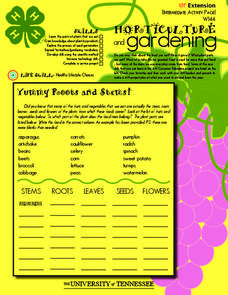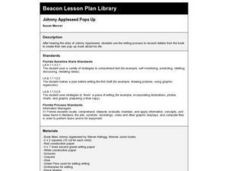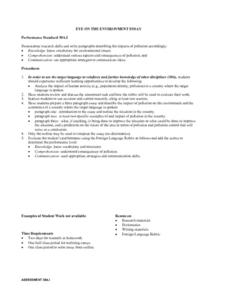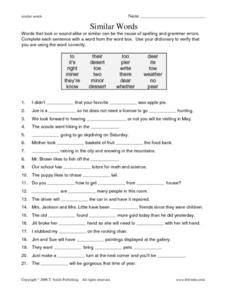Curated OER
Haunting Music
Students discover music that was inspired by the spooky and bizarre. In this music of Hector Berlioz and Camille Saint-Saens lesson, students identify elements of music and listen to the Symphonie Fantastique and Danse Macabre....
Curated OER
Bird Up
Third graders identify basic physical and behavioral characteristics of birds and how they adapt to their environments. To organize and share scientific information with peers. They discuss similarities and differences among birds....
Curated OER
4-H Horticulture and Gardening- Intermediate Learner's Page
In this 4-H horticulture and gardening worksheet, students study how some of the food they eat is the stems, roots, leaves, seeds, and flowers of plants by completing a fill-in-the-blank activity and a word search page. They examine the...
Curated OER
Histograms and Bar Graphs
Learners examine the use of bar graphs and histograms. In this data representation lesson, students investigate the proper use of bar graphs and histograms to represent data. They learn the proper geometric definitions, experience direct...
Curated OER
Jamestown's Economy
Students identify items made in Jamestown and draw conclusions about their economy. In this Jamestown economy lesson, students use the internet to complete a worksheet which required them to look at photographs of goods made in and...
Curated OER
Collars, Curtains and Kings: Exploring the History of Lace
Young scholars design to explore the world of objects as related to lace. Students will create a lace mural highlighting what they learn about the world of lace. Young scholars brainstorm ideas via the internet websites.
Curated OER
Horticulture and Gardening
In this colorful packet, students engage in a variety of activities involving plants and seeds. After answering the 50 questions in the packet, learners can go on to delve into their own projects.
Curated OER
Computers: Caught in the Web
Young scholars conduct Internet research about various websites noting the design and appearance of them. Working in small groups, they compare and contrast the sites and share their opinions of them with classmates. They also examine...
Curated OER
Imperial Notions
Students research how and why different parts of the world were colonized, considering the pros and cons for both the rulers and the ruled.
Curated OER
Food for Thought: Hunger???Around the Block, Around the World LESSON 2: Local Hunger and Malnutrition
Students examine the difference between hunger and malnutrition. They study the idea of hunger as a theme in literature while discovering how communities can solve hunger problems.
Curated OER
Doing Dewey Decimal
Students examine the Dewey Decimal System and locate books in the nonfiction section. They examine a shelf of books and try to determine how the books are arranged, then watch a short video "Media Mania." Students then match construction...
Curated OER
Surface Area of Prisms
Students compute surface area and volume of prisms. In this surface area instructional activity, students find the surface area and volume of rectangular and triangular prisms. Independently, students use their computers to determine...
Curated OER
Johnny Appleseed Pops Up
Students recount details from the book Johnny Appleseed to create their own pop-up book about his life.
Curated OER
Eye On the Environment Essay
Students analyze the impact of human activity (e.g., population density, pollution) to a country where the target language is spoken. They prepare a three paragraph essay and describe the impact of pollution on the environment and the...
Curated OER
Wolf Fact Cards
Students write a non-chronological report about wolves. They read and discuss wolf fact cards in small groups, complete a KWL chart, observe the teacher model the steps of writing a report, and conduct research and write an original...
Curated OER
The United States Flag
Students study the United States flag. In this American history and government instructional activity, students define and give examples of familiar symbols. Students design a classroom flag. Students identify and describe...
Curated OER
Opinions, Please!
Students discuss the meaning and purposes of polls and surveys. After reading an article, they analyze the results of a poll given to residents of New York City. They create a survey of their own and analyze the data to write a written...
Curated OER
Is That a Fact?
Students write examples of facts and opinions on the board. In groups, they develop their own definitions for facts and opinions and share with the class. In new groups, they complete a worksheet in which they place statements into the...
Curated OER
Similar Words
In this spelling and grammar activity, students study words which look or sound alike such as "desert" and "dessert." Students use the 24 words in the word bank to choose correct words to complete 20 sentences.
Curated OER
Acids and Bases
In this acid and base activity, students are given terms related to acids and bases and their definitions. Students match the proper definition to the terms but cutting out the definitions and gluing them next to the proper term.
Curated OER
Around the World Alphabet Book
Students explore the online dictionary portion of the EnchantedLearning.com website. They copy pictures and text to create an on-going, student-created classroom book which exposes them to different countries, cultures, animals, etc.
Curated OER
Cinquain Lesson Plan
Students read an example of a cinquain and look for patterns. In this cinquain lesson, students repeat the process with another poem and then compare the two. Students will review the process and form of writing a cinquain as presented...
Curated OER
Latitude and Longitude
Fifth graders study latitude and longitude. They estimate the latitude and longitude of their hometown and find the latitude and longitude of other cities using a map. They use a website to find out the cities' actual latitude and...
Curated OER
Great Gullah Story Telling Packet
Sixth graders examine the Creole language known as Gullah which is a form of speech comprised of a number of unrelated languages. They determine how slaves used this to communicate so that slave masters would not be able to understand...

























